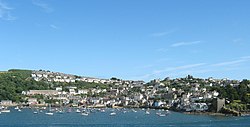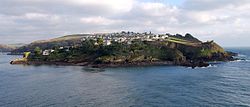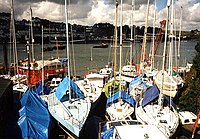Polruan
| Polruan Cornish: Porthruwan | |
| Cornwall | |
|---|---|
 Polruan viewed across the river from Fowey | |
| Location | |
| Grid reference: | SX126508 |
| Location: | 50°19’38"N, 4°37’60"W |
| Data | |
| Post town: | Fowey |
| Postcode: | PL23 |
| Dialling code: | 01726 |
| Local Government | |
| Council: | Cornwall |
| Parliamentary constituency: |
South East Cornwall |
Polruan is a small fishing village in the parish of Lanteglos-by-Fowey in Cornwall. It is bounded on three sides by water: to the north by Pont Creek, to the west by the River Fowey and to the south by the English Channel. To the north is its neighbouring village, Bodinnick, connected by a 4-mile walk along the hilltops.[1]
Polruan is built upon a very steep hill. The estuary here forms Polruan Pool, which is a sheltered water protected from the prevailing winds and so a haven for small boats.
The Polruan ferry crosses the river to and from Fowey every 15 minutes and operates every day of the year. There is also a ferry by way of Lostwithiel and Mevagissey. Cars can be ferried out to Fowey from Bodinnick which is 4 miles away.
History
Polruan has a history as a small fishing village known as a location for much old boat building. St Ruan was the first to occupy the top of Polruan Hill the point where St Saviour's ruin still stands today. The ruin of St Saviour's church on the hill above Polruan dates to the 8th century. It was a landmark for shipping, and also, in times of war, a vantage point for observing the approach of enemy shipping to the strategically important Fowey harbour.

Polruan also has a blockhouse fortification built in the 14th century that guards the entrance to the river Fowey, one of a pair—its partner being situated on the Fowey side of the river. The Polruan blockhouse well preserved due to the efforts of various enthusiastic councillors and conservationists on the Polruan side of the river, in contrast to the blockhouse in Fowey. Between the two blockhouses was strung a defensive chain to prevent enemy ships entering the harbour, the chain being lowered for friendly vessels. This was primarily used during the wars with the Dutch.
The Harbour Commissioners Yard was formerly a sardine processing factory which also supplied electricity for the village. The gun battery at Peak Point held an anti-shipping gun of which the mounting pin can still be seen. The battery gave the name of Battery Park. The wall at Peak Field was used for rifle practice. Motor torpedo boats were repaired at Pont Creek during Second World War. The overhanging trees hid the boats from surveillance aircraft. The remains of cradles for boat repair and some hull parts can still be seen preserved in the mud on the foreshore. Some boat-building still takes place in Polruan: Toms's Yard builds and repairs boats and has reputation for handling trawlers and also for hand building in wood.
Pilots and watchmen

Until recently, the Fowey Harbour Pilots traditionally came from Polruan. Pilotage for commercial shipping was carried out from open boats with the pilots boarding the ships in the traditional manner by a pilot ladder. The Fowey Pilots Association describes the work of the pilots.[2]
Polruan is one of a now increasing number of Cornish places to use watch towers to help marine craft in distress. Many lookout towers were demolished in the 1980s to save costs. Now, thanks to the National Coastwatch Institution (NCI), a voluntary charity, many of the surviving old Coast Guard huts and towers are being re-manned by qualified volunteers. The Watch house at Polruan was among the first to be re-commissioned in this way. (The current HM Coastguard headquarters for cliff rescue, including the equipment store, is on St Saviour's Hill adjacent to the NCI Watch house, above the main village carpark. Exercises of the HM Coastguard continue.[3]) The current Polruan watchtower overlooks the Fowey estuary and the bay beyond the village.[3] It was constructed in the nineteenth century.[3]
On film and television
The 1963 film Stolen Hours was filmed around Polruan. The film displays older shots of the village including use of the village shop, 'Headland House', and the clip of the children's sports day which is filmed where Greenbank is now built. A local, Mrs Baker/Bidmead, was included in the filming of the egg and spoon race and calls... 'Let's get shoes off!'
An episode of The Inspector Lynley Mysteries was also partly filmed in Polruan.
Outside links
References
- ↑ Berry, Oliver; Dixon, Belinda (15 February 2008). Devon, Cornwall & Southwest England. Lonely Planet. p. 269. ISBN 978-1-74104-873-5. http://books.google.com/books?id=tqpP0B-Hg7IC&pg=PA269. Retrieved 30 December 2010.
- ↑ "Fowey pilots". Foweypilots.com. http://foweypilots.com. Retrieved 28 August 2010.
- ↑ 3.0 3.1 3.2 Beardsall, Jonny (7 April 2007). "For those in peril". The Daily Telegraph. The Daily Telegraph Ltd. http://www.telegraph.co.uk/culture/3664299/For-those-in-peril.html. Retrieved 28 August 2010.